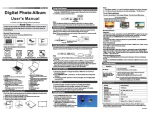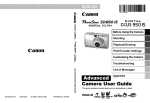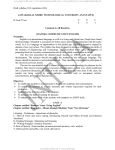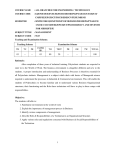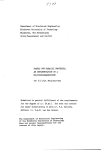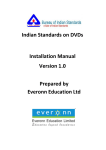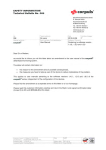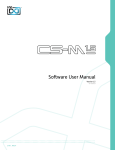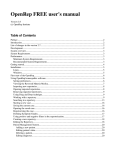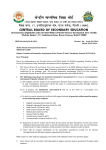Download IS 7583 (1991): Medical Electrical Equipment
Transcript
इंटरनेट मानक Disclosure to Promote the Right To Information Whereas the Parliament of India has set out to provide a practical regime of right to information for citizens to secure access to information under the control of public authorities, in order to promote transparency and accountability in the working of every public authority, and whereas the attached publication of the Bureau of Indian Standards is of particular interest to the public, particularly disadvantaged communities and those engaged in the pursuit of education and knowledge, the attached public safety standard is made available to promote the timely dissemination of this information in an accurate manner to the public. “जान1 का अ+धकार, जी1 का अ+धकार” “प0रा1 को छोड न' 5 तरफ” “The Right to Information, The Right to Live” “Step Out From the Old to the New” Mazdoor Kisan Shakti Sangathan Jawaharlal Nehru IS 7583 (1991): Medical Electrical Equipment - High Frequency Surgical Equipment [MHD 19: Immuno-Biological Diagnostic Kits] “!ान $ एक न' भारत का +नम-ण” Satyanarayan Gangaram Pitroda “Invent a New India Using Knowledge” “!ान एक ऐसा खजाना > जो कभी च0राया नहB जा सकता ह” है” ह Bhartṛhari—Nītiśatakam “Knowledge is such a treasure which cannot be stolen” ( Reaffirmed 1996 ) IS 7583 wyi&T : 1991 ( Reaffirmed 2001 ) WV6 Indian Standard MEDICAL BLECTRICALBQUIPMENTHIGHFREQUBHCYSURGICALEQUIPMENTSPECIFWATWN .. . fFirst Revi’sionJ’ ‘. ’ -. ’ UDC 615,846 @ BIS 1991 BUREAU MANAK OF BHAVAN, INDIAN 9 BAHADUR STANDARDS SHAH ZAFAR MAkG NEWF_ Decembtr 1991 .Price Group 7 *I Electromedical Equipment Sectional -Committee, MHD 19 FO-REWORD This Indian Standard ( First Revision ) was adopted by the Bureau of Indian Standards, after the draft finalized by the Electromedical Equipment Sectional Committee had been approved by the Medical and Hospital Planning Division Council. This standard was first published in 1974. This revision has been carried out ~to align it with IEC 601-2-2 ( 1982 ) ‘Medical electrical equipment: Part 2 Particular requirements for the safety of high frequency surgical equipment’ issued by the International Electrotechnical Commission ( IEC ). High frequency surgical equipment means of high frequency current. is used for surgical operations, such as, cutting and coagulation by The uqe of frequencies above O-3 MHz avoids the unwanted stimulation of nerves and muscles which result from the use of low frequency current. Normally, frequencies above 5 MHz arenot used in order to minimize the problems associated with high frequency leakage currents. However, higher frequencies may be used in the case of bipolar techniques. For the purpose of deciding whether a particular requirement of this standard is complied with, the final value, observed or calculated, expressing the result of a test or analysis, shall be rounded off in accordance with IS 2 : 1960 ‘Rules for rounding off numerical values ( revised )‘. The number of significant places retained in the rounded off value should be the same as that of the specified value in this standard, IS 7583 : 1991 Indian Standard MEDICAL ELECTRICAL EQUIP~MBNTHIGH FREQUENCY SURGICAL EQUIPMENT SPECIFICATION ( First Revision ) 1 SCOPE 3.4 Cutting 1.1 This standard specifies safety and performance requirements of high frequency surgical equipment used in medical practice. Section of body tissue caused by the passage of high frequency current of high current density at the point of the active electrode ( see 3.5 ). \ 3.5 Electrode, Active 1.2 Equipment having a rated output power not exceeding 50 W ( for example, for micro-coagulation, or for use in dentistry, or ophthalmology ) is requirements of this exempted from certain standard. These exemptions are indicated in the relevant requirements. 2 REFERENCES The following Indian Standards adjuncts to this standard: are necessary 3.6 Electrode, 302 : 1979 General and safety requirements for -household and similar electrical appliances ( f;fth revision ) 1885 ( Part 43 ) : 1977 Electrotechnical vocabulary: Part 43 Electrical equipment used in medical practice 68-12 : 1977 Limits for interference 8607 ( Set 1 to 10 ) Medical electrical equipment - General requirements for safety (first revision ) ( under prefiaration ) NOTE electrode, High Frequency ( hf ) Surgical Equipment electromagnetic (Jirst revision ) Medical electrical equipment including its associated accessories intended for the performance of surgical operations, such as, cutting or coagulation of bicjlogical tissues by means of high frequency ( hf) current. 3.9 Rated 4 GENERAL Part neutral Output Power Maximum high frequency power which can be. fed into a non-reactive load resistor having a resistance between 50 and 2 000 ohms in case of a monopolar output circuit and between 10 and 1000 ohms in case of bipolar circuit, 3.1 The following definitions, in addition to those given in IS 1885 ( Part 43 ) : 1977, shall apply. active, The neutral electrode is also known as plate passive or dispersive electrode. 3.8 3 TERMINOLOGY Output circuit including bipolar electrodes. Neutral Electrode of relati&ly large area for connection to the body of the patient to provide a return path for the high frequency current with such a low current density in the body tissue that physical effects, such as, unwanted burns are avoided. NOTE - Till such time the standard under preparation is published, the matter shall be as agreed to between the concerned parties. 3.2 Applied .Bipolar Assembly ~of two active electrodes on the same support and so energized that the current flows mainly between these two eletrodes. 3.7 Electrode, Title IS No. Electrode intended to produce certain physical effects required in electrosurgery, for example, cutting and coagulation. REQUIREMENTS Relevant provisions shall apply. and 5 GENERAL 3.3 Coagulation of IS 6607 ( Set REQUIREMENTS 1 to 10 ) FOR TESTS 5.1 Provisions of IS 8607 ( Set 1 to 10 ) shall. apply except additional routine tests ( see 11.12 ). Sealing of small blood vessels or body tissues caused by the passage of high frequency current at the active electrode ( see 3.5 ). 5.2 Where reference is made in test specifications. to electrode cables and/or electrodes, those 1 18 7583 s r991 supplied or recommended shall be used. by the manufacturet 5.3 Sequence The test called for protection against the effects of defibrillator discharge shall be performed prior to the leakage current and dielectric strength tests. a) Greem - Power supply switched on; b) Yellow --Output circuit energized but where cutting and coagulation output may be separately selected, two lights may be incorporated and if so, they shall have the following colours: Yellow : Cutting, and 6 CLASSIFICATION The equipment Type BF or CF. shall 7 IDENTIFICATION, be of Class I or 11, and MARKING AND DOCUMENTS Each apparatus shall be marked indelibly and clearly with the following information on a plate fixed firmly to it: 4 Indication of the source of manufacture, W Type designation, 4 Fabrication number, 4 Supply voltage or voltage range, e) Current in amperes, f 1 Operating frequency in MHz, i 69 Phase, and Rated output power in watts and the load h) resistance at which this power is available. Marking on the Outside If relevant, the symbol indicating the type of protection against electric shock shall also indicate that protection against the effects of defibrillator discharge is incorporated. 7.2 Marking 7.2.1 Graduation of the output power control scale in 10 major intervals is recommended. 7.3 The location of all components shall be marked for easy identification or re-location during maintenance/repair. 7.4.1 7.4.2 have the same colour Audio- Visual Device 7.5 Accompanying Push Buttons and Audio- Coloursof Indicator Lights and Push Buttons Where indicator lights are incorporated, they shall have the following colours and provide the indications shown against each: Documents Each apparatus shall be provided with the instructions for use and a technical description giving the following details: a) Rated voltage; b) Frequency of supply; c) Symbol for protection class; d) Details of trolley ( see 9.11 ); e) Degree of radio interference; of interference field strength and NOTE -Limits interference voltage for electromedical apparatus have been laid down in IS 6842 : 1972. f) Rated output and corresponding load resistance; g) working frequency Rated ( nominal generated frequency in MHz for shortwave and in RHz for surgical units ); ef Controls The output control shall additionally have a scale and/or associated indicator showing relative units of high frequency output. The figure ‘0’ shall not be used unless no power is delivered in -this position. ,7.4 Indicators, Visual Device Alternatively, knobs may code wasstated above. A fail safe audio-visual device shall be provided to indicate fault condition in patient circuits. 7.1 Marking 7.1.1 : Coagulation. Blue Nominal output in watts ( maximum high frequency output given by the apparatus ); 9 Manual containing k) Maintenance/service n-4 Parts list; and 4 Circuit diagram. 7.5.1 Instructions contain: for operating instruments; manual; use shall additionally concerning the a>Information of high frequency cables in compatibility order to prevent the use of unsuitable cables; and b) Notes on the application of high frequency surgical equipment. These shall draw the attention of the user to certain precautions which are necessary in order-to reduce the risk of accidental burns. IS 7883 a 1891 7.5.1.1 In particular, advice shall be given on the following: a) cotton wool and gauze, when saturated with oxygen, may be ignited ~by sparks produced in normal use of the equipment. The neutral electrode should be reliably attached with its entire area to the patient’s body and as close to the operating field as possible. patient should not come into contact with metal parts which are earthed or which have an appreciable capacitance to earth ( for example, table, operating supports, etc ). The use of antistatic sheeting is recommended for this purpose. W For patients with cardiac pacemakers or pacemaker electrodes, a possible hazard exists because interference with the action of the pacemaker may occur or the pacemaker may be damaged. In case of doubt, reference should be made to the cardiology department for advice. ml The possibility of interference to other medical electrical equipment due to the operation of high frequency surgical equipment. b) The 4 d) Skin-to-skin contact ( for example, between the arms and the body of the patient ) should be avoided, for example, by insertion of dry gauze. 7.5.4 The technical description following output data: When high frequency surgical equipment and physiological monitoring equipment is used simultaneously on the same patient, any monitoring electrode not incorporating protective resistors or high frequency chokes should be placed as far as possible from the surgical electrodes. Needle monitoring electrodes are not recommended. 4 Diagrams showing the power output at fulland half-setting of the output control over the range of load resistance 50 to 2 000 ohms for the following operating modes, if available, 1) Cutting, 2) Coagulation, The cables to the surgical electrodes should be positioned in such a way that contact with the patient or other leads is avoided. For surgical procedures on parts of the body having a relatively small cross-sectional area, the use of bipolar techniques may be desirable to avoid unwanted coagulation. and b) 3) Blend, any variable; ‘Blend’ control being set to the maximum position; Diagrams showing the power output versus the output control setting at a specified load resistance in the range 50 to 2 000 ohms for the operating modes listed above; and 4 Designation ( see 11.2 ).. 8 SAFETY The output power selected should be as low as possible for the intended purpose. of the applied part(s) REQUIREMENTS 8.1 The equipment shall satisfy the safety requirements of IS 8607 ( Set 1 ). Apparent low output or failure of the surgical equipment to function‘ correctly at normal operating settings may indicate faulty application of the neutral electrode or poor contact in its connections. 3 shall contain the relevant 8.2 To avoid safety hazards, the following considerations should be taken into account: the distance a>Minimizing rating field and the between the opec neutral electrode reduces the load resistance, and for a given power at the site of the active electrodes, the power output required from the equipment and also the high frequency voltage across the patient so as to reduce the hazard of unwanted burns; The use of flammable anaesthetics and nitrous oxide ( N,O ) and oxygen should be avoided if a surgical procedure is carried out in the region of thorax or the head unless these agents are sucked away or anaesthetic-proof~equipment is used. Flammable agents used for cleaning or disinfecting or as solvents of adhesives should be allowed to evaporate before the application of high frequency surgery. There is a risk of pooling of flammable solutions under the patient or in body depressions, such as the umbilicus and in body cavities, such as, the vagina. Any fluid pooled in these areas should be mopped up before the equipment is used. Attention should be called to the danger of ignition of endogenous gases. Some materials, for example, b) cl 4 3 Small area contacts with objects having a low impedance to earth at high frequencies may result in high current densities and hence unwanted burns; There may be some high frequency voltage difference between these parts of the patient’s body which may cause -an unwanted current to flow; The current flowing to the leads of the monitoring equipment may cause burns at the site of the electrodes; xs 7563 .: 1991 4 The capacitance between the electrode * cable and th e patient ‘may result in some local high current densities; f) Specially where bony structures and having a relatively high resistance are involved, bipolar techniques can avoid unwanted tissue damage; .d h) Output power shall be minimum required; 3 It should be made clear to -the user whether the applied part is completely floating or referenced to earth at high frequency. 9.5 Output Indicator A device shall be incorporated which gives an audible signal when any output circuit is energized by the operation of an output switch or as a result of a single fault condition. The sound output shall have its major energy content in the band of frequencies between 100 and S 000 Hz. The sound source shall be capable of producing a sound level of at least 65 dBA at a distance of lm from the equipment. An accessible sound level control may be provided but shall not reduce the sound level below 45 dBA. Techical description, output data and diagram shall be provided. These diagrams should enable the user to judge the suitability of an equipment for a particular purpose; and 9.5.1 In order to enable the user to distinguish between the audible alarm called for in 9.4 and the signal specified above, either the former shall be pulsed or two -different frequencies shall be employed. 9 CONSTRUCTION 9.1 Provisions of IS 8607 except as stated below. 9.5.2 Compliance shall be checked by functional check and measurement of the sound level. ( Set 10 ) shall apply 9.6 Neutral Electrode 9.2 Switches 9.6.1 Except for any output circuit intended only for connection to a bipolar electrode, equipment having a rated output power in excess of 50 W shall be provided with a neutral eletrode. In addition to the mains switches, an output switch ( finger or foot switch ) shall be provided requiring continuous activation to energize the output circuit. 9.6.1.1 Compliance inspection. 9.2.1 The switching circuit shall be supplied from a power source isolated from the mains part and from earth and having a voltage not exceeding 12 V if a conductive connection to the applied part exists, and 24V ac or 34 V dc in other cases. by 9.6.4 The neutral electrode shall be reliably connected to the cable. Any current used for monitoring electrical continuity of the electrode cable and its connections shall pass through a section of the electrode. 9.3 Cord Connected Foot Switches The force required to actuate the foot switch shall be between 10 and 15 N. 9.6.4.1 Compliance shall be checked by inspection and test of the electrical continuity. Circuit Equipment having a rated output power of more than 50 W and an applied part not isolated from earth at high frequencies to the degree required in this standard shall be provided with a circuit arranged so as to de-energize the output and to give an audible alarm when an interruption of the neutral electrode cable or its conuections occurs. The audible alarm shall meet the sound level requirements of 9.5.2 and shall not be externally adjustable. should checked 9.6.3 The neutral electrode of equipment having a rated output power of not more than 50 W may be capacitively coupled to the patient. 9.2.3 Compliance shall be checked by inspection, functional check, and measurement of voltage and leakage current(s). NOTE - An additional visible warning provided consisting of a red indicator light. be 9.6.2 The neutral ~electrode should be so designed that it provides, with a margin of safety an adequate area of contact with the body and allows a return path for the high frequency current with such a low current density in the body tissue that adverse physiological or physical effects are avoided. 9.2.2 Under single fault condition, this circuit shall not cause low-frequency patient leakage current(s) exceeding the allowable limits. 9.4 Monitoring shall 9.7 Neuromuscular Stimulation To minimize the possibility of neuromuscular stimulation, the dc resistance between active and neutral electrode terminals or between the terminals of a bipolar output circuit shall be not less than 2 MQ. 9.7.1 The effective series capacitance exceed 5 000 PF. should not 9.7.2 Compliance shall be checked by inspection of de resistance between the output terminals. be 4 9.8 Cooling 9.13 Human grruwa Fans 9.8.1 Cooling fans, if incorporated, shall be so arranged that in normal use, any draught is directed away from the patient. 9.8.2 Generally, avoided. the use of cooling fans should he 9.8.3 Compliance shall be checked by inspection of the equipment and the accompanying documents. 9.9 Anaesthetic-Proof Surgical Equipment High Frequency 9.9.1 At least the applied part of equipment specified for use with flammable anaesthetics shall be anaesthetic-proof and marked ‘AP’ and shall comply additionally with the following requirements. 9.9.1.1 Cutting or coagulation electrodes shall be provided with a holder equipped with a means for directing a stream of inert gas towards the operating site. The arrangement shall be such as to ensure that the inert gas flow is started at least 1 second before the output is energized and the gas flow is stopped only after the output is de-energized. 9.13.1 Where a double foot switch assembly is used to select cutting and coagulation output modes, the arrangement shall be such that when viewed by the operator, the ‘cut’ pedal is on the left and the ‘coagulate’ pedal on the right-hand side. 9.13.1.1 Compliance inspection. 9.13.2 Where the porates two finger the electrode shall the switch further coagulation mode. shall be checked by active electrode holder incorswitches, the switch nearer to activate the cutting mode and from electrode shall activate the 9.13.2.1 Compliance inspection. shall be checked by 9.lj.3 Operation of a single output switch shall not result in the simultaneous energizing of more than one active electrode. 9.13.3.1 For the purpose of this requirement, a bipolar electrode is considered to be one active electrode. 9.13.3.2 Compliance shall be inspection and functional check. checked by NOTE - Inert gas, ~for example, nitrogen or carbon 9.13.4 Connectors for active and neutral electrode dioxide, at flow rate of 3 to 5 l/min have proved shall not be interchangeable. adequate in practice. 9.13.4.1 Compliance shall be checked by inspection. 9.9.2 Compliance shall be checked by the test of 11.4. 9.14 Electromagnetic Compatibility 9.10 Rated Output The equipment set up to deliver its rated output power into a resistive load using the electrode cables is operated for 1 hour with a duty cycle as specified by the manufacturer but minimum with an operating time of 10 seconds and resting time of 30 seconds. 9.11 Spillage The equipment shall be placed on a trolley, approximately 600 mm in height, so that the liquid spillage in normal use does not wet electrical insulation or other components which, when wetted, are likely to affect adversely the safety of the equipment, The relevant test shall be carried out only on the front panel of the equipment and switch to conform to the protection of internal device during normal operation. 9.12 Ingress of Liquids The electrical switching parts of foot switches for high frequency surgical equipmant intended for use in operating rooms shall be of watertight construction. The equipment shall comply with the requirement specified in CISPR Publication 11 ‘Limits and methods of measurement of radio interference characteristics of industrial, scientific and medical ( ISM ) radio-frequency equipment excluding surgical diathermy apparatus’ when the equipment is energized but the output switch is not activated. 10 ACCURACY OF OPERATING DATA AND PROTECTiON AGAINST INCORRECT OUTPUT 10.1 Accuracy of Operating Data 10.1.1 Equipment shall incorporate means ( an output control ) to enable the output power to be reduced to not more than 5 percent of the rated output power or 10 W, whichever issmaller ( see 7.2 ). In the load resistance range IO0 to 1 000 Q, the output power shall increase with the increase of the output control setting. 10.1.2 For output powers in excess of percent of the rated output power, the actual power as a function of load resistance and output control setting shaI1 not deviate from that shown in the diagrams specified in 7.5.2 by more than f20 percent. IS 7583r1991 10.2 Protection Against Incorrkct Output : ’ 10.2.1 The rated output power shall not exceed 400 W for any operating mode averaged over any period of 1 second. 10.2.1.1 Compliance shall be checked by inspection of marking and output power-load resistance curves. 10.2.2 When the equipment is switched off and again switched on, the mains supply is interrupted and re-established, the following requirements shall be complied with: a>The output power for a given setting of the output control shall not increase by more than 20 percent, and b) NOTE - The term ‘casing’, as used above, inclddPj all accessible metal parts, shafts of carrying handles and knobs and similar components, and a metal foil not larger than 200 mm x 100 mm which lies on the surface of the external parts of insulating material. The metal foil shall have the largest area possible that can he placed for the test on the -surface of the apparatus to be tested, but shall not be larger than the dimensions stated above. 11.2 Test for High Frequency.Lieakage Current 11.2.1 The applied part shall, depending on its design, comply with the relevant section of the following requirements: 4 The mode of operation shall not be chang ed except to a stand-by mode m which no output is produced. 10.2.2.1 Compliance shall be checked by measurement of output power averaged over a period of 1 second and the observation of the operating mode : a) with repeated operation of the mains switch of the equipment; and b) with interruption and re-establishment of the mains supply, the switch in the equip ment being left in the ‘on’ position. Compliance shall be checked by the following tests: Test 1 - The test is performed on the equipment with the electrode cables and electrodes as shown in Fig. 1. The cables are spaced 0.5 m apart on an insulating surface 1 m above the floor or any conducting plane. The output is loaded with 200 Q and the equipment is operated at maximum output setting in each operating mode. The hf leakage current flowing from the neutral electrode through a non-inductive resistor of 200 Q to earth is measured. 11 TESTS 11.1 High Voltage and Insulation Resistance Test ( Routine Tests ) 11.1.1 High Voltage’Test 11.1.1.1 High voltage test shall be carried out in accordance with Annex A. The test voltage between output circuit and any other terminal of the unit having U as their working voltage shall be 2 u + 500 v. 11.1.1.2 The surgical apparatus is operated with 110 percent of the rated supply voltage for 30 minutes and after this operation, the high frequency insulators shall be checked for no change and satisfactory operation. 11.1.2 Insulation Resistance Test The insulation resistance test is performed with direct voltage of approximately 500V immediately after the humidity treatment specified in 4.10 of IS 8607 ( Set 1 ) the measurement being made one minute after the application of the voltage and heating elements, if any, being disconnected. The insulation resistance is measured. The measured ,value betweenlive parts and the casing shall not be less than those stated below: a) For functional insulation : 5 M f~, and b) For reinforced i&ulat;on : 7 M &2. electrode reference to earth - The applied part is isolated from earth but the neutral electrode is referenced to earth at high frequencies by component ( for example, a capacitor ) satisfying the requirements of Type BF equipment. When tested as described below, the hf leakage current flowing from the neutral electrode through a non-inductive 200 Q resistor to earth shall not exceed 150 mA. Neutral Test 2 - The equipment is set up as for Test 1 but the 200 Q load resistor is connected between the active electrode and the protective earth terminal, of the equip ment as shown in Fig. 2. The hf leakage current flowing from the neutral electrode is measured. b) .&=&al electrode isolated from earth at high frequency - The applied part is isolated from earth at both high and low frequencies and the isolation shall be such that the hf leakage current flowing from each electrode through a 200 SJ non-inductive resistor to earth does not exceed 150 mA when tested as described below: The equipment is set up as described in 11.2.1 (a) Test 1, the output being unloaded. Any metal enclosure of Class II equipment and internally powered equipment shall be connected to earth. Equipment having an insulating enclosure shall’ be positioned on earthed metal having an‘ IS-‘1583 : 1991 area at least equal to that of the~base of the equipment during this test ( see Fig. 3 ). The hf leakage current is measured from each electrode in turn while the equipment is operated at maximum output setting in each operating mode. -4 applied part application - Any Bipolar specifically designed for bipolar application shall be isolated from each and from other applied parts frequencies. at 11.2.1.1 The hf leakage under consideration. both current high and requirements low are 11.2.1.2 In the case of equipment, specified for permanent installation, the tests shall be carried out with the equipment fitted with mains supply cord having a length of 3 m. lm 1 - SUpply mains 2- Table made of insulating material 3 - hf surgical equipment Active electrode 45- Neutral electrode, metallic or in contact with metal foil of the same size 6- Load resistance, 200 ohms 7 8 - Measuring hf current resistance, meter 200 ohms -FIG.1 MEASUREMENTOF hf LEAKAGE CURRENT, EARTH REFERENCED,LOAD BETWEENELECTRODBS P La 2!i I r lm _A_ . Fig. l., FIG. 2 M.EASURBMBNYOFhf LEAKAGE CURRENT, EARTI+REFERENCED?,LOADFROM krlVB For legends 1 to 8, see ELECTRODE TOEARTH 7 3 For legends 8 1 to 8, see Fig. 1. FIG. 3 MEASUREMENTOF hf LEAKAGE CURRENT,EQUIPMENTINSULATEDAT hf with the equipment set to maximum output.. Where selection ‘cut or coagulate’ modesis provided, the equipment shall be tested in each of these modes. The test shall be performed with all electrodes supplied for use with the equipment. 11.2.1.3 The requirements in 11.2.1 (a), (b) ayd (c+n;pply for both Type BF and Type CF equlp11.2.1.4 Requirements fo? hf enclqsure currents are under consideration, 11.3 Dielectric 11.3.1 Relevant Strength leakage Test provisions of IS 8607 ( Set 3 ) shall apply. 11.3.1.1 In addition, requirements electrode cables are given in 11.11. and tests for 11.4 Test Equipment for Anaesthetic-Proof 11.5 Output ‘Test 11.5.1 Requirements the following test: of 10.1 shall be verified by Measurement of output power as a function of output control setting at four .values of toad resistance in the range 100 to 1 000 ohms, for example, at 100, 200, 500 and 1000 ohms. The electrode cables shall be used for connection of the load resistors. The high frequency current I is measured through the known resistance R and the output W is obtained by the formula Compliance for anaesthetic-proof high frequency surgical equipment shall be checked by the following tests: of time interval between the a>Measurement commencement of the flow of in-ert gas from W-I’R. the electrode holder and the energization of the output ( see also B-l.4 ). b) 6 11.5.2 Compliance of 10.1.2 shall be checked by performing the test of11.5;1 but using appropriate values of load resistance. Verification that the flow of inert gas is maintained as long as the output is energized ( see also B- 1.4 ) . Cl A test for ignition is performed with the device shown in Fig. 4. The cotton wool plug in the trough (1) is wetted with a few millilitres of ether. The ether vapour flows via the gutter (2) on to the metal plate (3). The handle (5) with the electrode approximates the metal plate at a distance of about 150 mm from the end of the gutter. Sparking at the electrode shall not produce ignition of the ether mixture or #air Mixture. The’test ’ shall -be pidmhed 11.6 Protection Against DeBbrillator Discharge the Effects of Equipment having a rated output power of more than 50 W shall be provided with protection against the effects of the discharge of a cardiac defibrillator tested 5 times at an output of 400 J from the defibrillator. Such equipment shall be permanently marked on the front panel to indicate that such protection is-incorporated and this shall be tintied in the Wcempahying d6ctimehts. 8 IS 7583 : 1991 12345- Trough withcottonwool plug Gutter Metal plate Gone of inert gas Handle with active electrode All dimensions in millimetres. FIG. 4 1- 23- IGNITION TBST FOR ANAESTHETIC-PROOF EQUIPMENT DC voltagesource High frequencysurgicalequipment Metal plate for equipment 4- Resistance, RL 6 50 ohms 5 - Resistance, 6 - Resistance, 7 - Capacitance, having an enclosure of insulating material 10 ohms 100 ohms C = 32p F FIG. 5 TBST FOR DEFIBRILLATORPROOPNBSS 11.7 Spillage Compliance shall be checked by the following test: A quantity of one litre of water is poured steadily on to the middle of the top surface of the equipment over a period of 15 seconds Equipment intended to be built into a wall or cabinet is test by pouring water mounted as recommended into the wall above the control panel. After this treatment, the equipment shall withstand the dielectric strength test and inspection shall show no trace of water on insulation for which creepage distances are specified in IS 8607 ( Set 10 ). 11.8 Ingress Compliance test: of Liquids shall be checked by the following The foot switch shall be completely immersed in water to a depth of 150 mm for a period of 30 minutes. While immersed, it shall be connected in a circuit corresponding to its normal operation and actuated 50 times. After completion of this test, the switch shall be inspected. There shall be no evidence of entry of water and the switch shall pass the dielectric strength test specified in 11.3. 9 11.9 Protection Short-Circuitiug Against the Effect of Electrodes of 11.11.3 Compliance following tests: The equipment shall be capable of withstanding without damage, the elects of short-circuiting or open-circuiting the output when energized at maximum output setting. 4 11.9.1 Compliance shall be checked by the following test: The electrode cables and electrodes are connected to the equipment and the output control set to the maximum position. The output is then switched on and the active and neutral electrodes are shortcircuited for a period of 5 seconds and then opencircuited for a period of 15 seconds. The output is then switched off for a period of 1 minute. The above cycle is repeated for a total of 10 times. shall Circuit be checked by the following A circuit consisting of 1 000 ohm resistor in parallel with a switch is connected in series with the neutral electrode lead. The equipment is operated so as to deliver the rated output power into a resistive load and the switch is closed and opened five times. The alarm shall operate and the high frequency output shall be disabled at each opening of the switch. NOTE-Care should be taken to see that under normal conditions, the monitoring circuit does not introduce any interfering -voltage ( for example, at mains frequency or its harmonics ) at the neutral electrode which can adversely effect the operation of any patient monitoring equipment. 11.11 Test for -Electrode and Handles Cables, Connectors checked by the - Approximately 200 mm. of the cable to be tested is formed into a loop by joining suitably bared conductors at each end. It is lowered into water, the conductivity of which has been increased by the addition -of a small amount of salt until a total length of 100 mm of insulated. cable has been immersed. The cable shall remain in water for at least 24 hours following which the test voltage shall be applied for 5 minutes between the conductor or conductors and the water. Main frequency - A test sample of the cable is prepared and immersed as in test at 11.11.3(a). A quantity of transformer oil. is then added, just sufficient to produce a visible continuous film on the water surface ( this technique reduces the curvature of the meniscus ). High frequency voltage produced by the equipment via a 1 : 2 setup high frequency transformer is applied between the cable conductor and a bare conductor in water while the equipment is operated in each output mode in turn at the maximum setting of the corresponding control for 30 seconds. this test, the equipment shall comply with all the requirements of this standard. Compliance test: be W High frequency 11.9.1.1 After 11.10 Test for Monitor shall 11.11.3.1 During these tests, flashover shall occur. no breakdown or 11.11.4 The handle for the active electrode and its cable shall fulfil the relevant requirement of IS 8607 ( Set 7 ) regarding sterilization. 11.11.5 Any connector provided for attachment. of the neutral electrode to its cable shall be so designed as to prevent conductive contact with the body of the patient in the event of inadvertent disconnection. 11.11.1 The insulation of electrode cables whether or not specified for reuse, shall be capable of withstanding a mains frequency voltage of 3 000 V rms and a high frequency voltage of twice the maximum open-circuit high frequency voltage of the equipment. Compliance is checked by the following test: 11.11.2 High frequency dielectric strength test for the active electrode handle is under consideration. 11.12 Additional Annex B. Any cable to neutral electrode connector is disconnected from the electrode and using the standard test finger shown in IS 8607 ( Set 3 ), it is verified that contact with conductive parts of the cable connector is not possible. 10 routine tests are given in IS 7583 819911 ANNEX A ( Clause 11.1.1 HIGH VOLTAGE High voltage is made with alternating voltage of substantially sine wave form and having a frequency of 50 Hz after the humidity treatment specified in IS 302 : 1979 and when the apparatus .has attained its operating temperature. A-l A-l.1 In order to prevent circuit-making impulses, the test voltage is increased within 10 seconds from 500 V to its final value and then maintained for one minute. A-l.2 During this test, breakdown or flashover shall not occur; no objection shall be made to corona phenomena. The magnitude of test voltage and the points for high voltage test are stipulated in Table 1. ) TEST If it is not possible to make interruptions in circuits without damaging the apparatus for the test, the manner in whirLthe purpose of this test can be achieved by other means, shall be subject to agreement between the manufacturer and the testing authority. In intermediate circuits separated from the~mains part and within the applied part, the high voltage test is only.made if by bypassing the insulation between the live parts, danger may occur to the operator, the patient or the surroundings, or if currents over 300 I+A ( peak ) or voltages over 24 V can be transmitted to the applied Part. A-Z.1 The operation of a series-connected overcurrent protective part or an overload protection device in the apparatus may constitute a danger within the meaning of this specification. A-2 Table 1 Test Vohage ( CluuscA- 1.2 ) 91 No. Vohge Test Voltage (V) ~--‘-__-*__-_--_~ Protection Class I (1) 9 ii) (2) Between all parts having a conducting connection with the mains ( mains part ) on the one hand and the applied part and the casing on the other hand. iv) (3) 1 u + 1 000 2 ODO,Min (4) 500 2 u + 1000 1 500, Min 500 2 u + 1 000 1 500, &fin Between parts within the mains part ( input part ) or within the applied part ( output part ), between which occurs a voltage U: a) U up to 24 V b) U over 24 V iii) Protection Class II Between parts of Class II apparatus: a) Between the mains part and nonaccessible metal parts ( functional insulation ) of the Class II apparatus b) Between non-accesible metal parts and casing ( supplementary insulation ) of a Class II apparatus Insulating - 1 500 - 2 500 1 500 2 500 1 500 2 500 1 500 2 500 linings, knobs and lead entries: a) Between metal casings having an insulating lining and metal foil on the inner surface of the lining when the clearance between functionally insulated parts which are subjected to mains voltaee and the metal. casine smaller than ” the clearances spesfied in IS 302 : 1979. b) Between metal foils on actuating part ( knobs, handles and similar components ) and their spindles when these spindles can become live in the case of a fault. c) Between metal casings and either of the metal foil wrapped round the fixed connection lead inside inlet guard. NOTE - The insulation between live parts in accordance with item insofaras doubt with regard to~high voltage arises after inspection. (ii) is tested only IS 7563 : 1991 A-2.2 The insulation between the contacts of microswitches, thermostats, thermal cut outs, relays, etc, and the insulation of capacitors are not tested. A-3 In the case of Class II apparatus which has been reinforced and double insulated, care should be taken that the voltage applied to the reinforced insulation does not overstress the functional or supplementary insulation. When testing insulating coating, the metal foil may be pressed against the insulating material by means of a sand bag of such a size that the pressure is approximately O-005 N/mm*. A-3.1 Care should be taken to ensure that the metal foil is positioned in such a manner that. flashover does not occur at the edges of the insulation. A-4 High voltage test may be limited to places where the insulation is likely to be weak, for example, where there are sharp metal edges under the insulation. A-4.1 If possible, insulating separately. ANNEX linkings shall be tested. B (Clauses 11.4 and 11.12) TESTING B-l ADDITIONAL DURING ROUTINE MANUPAC Functional B-l.3 Measurement test of any monitoring of rated output B-l.4 For anaesthetic-proof equipment, ing test is required to be carried out. circuit. power. the follow- INSTALLATION The air/ammonia mixture will produce -a change in the colour of the indicator paper corresponding to the area of the gas flow surrounding the active electrode. The test should be repeated with all the active electrodes supplied for use with equipment, the hf output control may be set to minimum power throughout the test. In each case, the entire electrode shall be within the stream of gas as shown by the indicator paper. The test may be used to check compliance with the requirement that the inert gas ilow is started before the output power is switched on and that the gas flow stops after the output power is switched off. B-1.4.1 The test is performed with the device shown in Fig. 6. Instead of the inert gas normally used, compressed air is fed with a flow of 3 to 5 litres per minute through the handle, The supply pipe is connected to bottle having a capacity of approximately one litre which contains 700 ml of an aqueous solution of ammonia. The handle . AND/OR with electrode is directed towards the plate which is covered with a suitable indicator paper ( for example, universal @H indicator paper, range l-10 ) which has been moistened with water. TESTS B-l.1 Measurement of dc resistance between the active and neutral electrode terminals or between the two terminals for a bipolar electrode, respectively ( see 9.7 ). B-1.2 TURE 12 ._ IS 7585 t m9.1. INDICATOR -7 HANDLE ACTIVE ‘-- WITH ELECTRODE CONE OF GAS 14IXTURE _ --Q-----_ ----- N=ZZT ‘- BOTTLE -_ -_ -- 6 I I 1 / / FIG. 6 AD~TIONAL ROUTINE TBST FOR ANAESTHBTIC~ROOF EQUIPMENT 13 -, / Standard Mark The use of the Standard Mark is governed by the provisions of the Bureau of Indian Standards Act, 1986 and the Rules and Regulations made thereunder. The Standard Mark on products covered by an Indian Standard conveys the assurance that they have been produced to comply with the requirements of that standard under a well defined system of inspection, tosting and quality control which is devised and supervised by BIS and operated by the producer. Standard marked products are also continuously checked by BIS for conformity to that standard as a further safeguard. Details of conditions under \Yhich a licence for the use oft he Standard Mark may be granted to manufacturers or producers may be obtained from the Bureau of Indian Standards. Bweao of Indian Standards BIS is a statutory institution established under the Bureau of Indian Standards Act, 1986 to promote harmonious development of the activities of standardization, marking and quality certification of goods and attending to connected matters in the country. Copyright BIS has the copyright of all its publications. No part of these publications may be reproduced in any form without the prior permission in writing of BIS. This does not preclude the free use, in the courseof implementing the standard, of necessary details, such as symbols and sizes, type or grade designations. Enquiries relating to copyright be addressed to the Director ( Publications ), BIS. Revision of Indian Standards Indian Standards are reviewed periodically and revised, when necessary and amendments, if any, are issued from time to time. Users of Indian Standards should ascertain that they are in possession of the latest amendments or edition. Comments on this Indian Standard may be sent to BIS giving the following reference: Dot : No. MHD 19 ( 2220 ) Amendments Issued Since Publication Date of Issue Amend No. .I . --- 7 __ Text Affected _. . -- .’ ‘1*, - BUREAU OF INDI-AN STANDARDS Headquarters : Manak Bhavan, 9 Bahadur Shah Zafar Marg, New Delhi 110002 Telephones : 33101 31,331 13 75 Telegrams : Manaksanstha ( Common to all Offices ) Regional Ofaces f Telephone Central I Manak Bhavan, 9 Bahadur Shah Zafar Marg NEW DELHI 110002 331 01 31 1 331 13 75 Eastern a l/14 C. I. T. Scheme VII M, V. I. P. Road, Maniktola CALCUTTA 700054 87 86 62 Northern t SC0 445-446, Sector 35-C, CHANDIOARH 160036 53 38 43 Southern t C. I. T. Campus, IV Crou Road, MADRAS 600113 235 02 18 Western t Manakalaya, E9 MIDC, Marol, Andherl ( East ) BOMBAY 400093 632 92 95 BANGALORE. BHOPAL. Branches : AHMADABAD. BHUBANESHWAR. COIMBATORE. FARIDABAD. GHAZIABAD. GUWAHATI. HYDERABAD. JAIPUR. KANPUR. LUCKNOW. PATNA. THIRUVANANTHAPURAM. Printed at New India Printinn F&u. Khurie. India




















